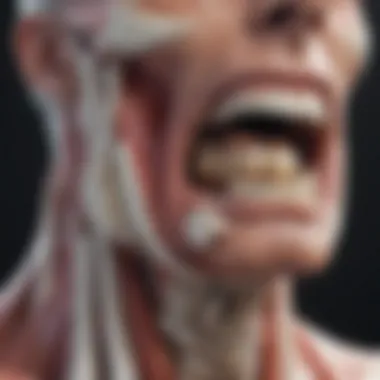TMJ Splint Therapy Success: An In-Depth Exploration


Intro
Temporomandibular disorders (TMD) encompass a range of issues related to the jaw, face, and temporal area. They can lead to significant discomfort, affecting an individual’s quality of life. TMJ splint therapy has emerged as a viable treatment option for managing these disorders, often providing relief where other methods fail. Understanding the effectiveness of this therapy requires a close examination of its mechanisms, benefits, and the various challenges faced by patients.
In this article, we will explore the efficacy of TMJ splint therapy by reviewing existing literature and sharing insights from clinical practice. We will examine key elements such as patient selection and adherence to treatment as well as the different types of splints available, thereby elucidating factors that influence treatment outcomes. The goal is to provide clarity and context on TMJ splint therapy’s role in managing temporomandibular disorders.
Research Highlights
Overview of Key Findings
Research has shown that TMJ splint therapy can lead to a reduction in pain and improvement in jaw function for many individuals suffering from TMD. Studies indicate that the use of these splints helps to stabilize the position of the jaw, thereby reducing strain on the temporomandibular joint and surrounding structures.
Additionally, qualitative data suggests that patients often report a better quality of life after undergoing TMJ splint therapy, though outcomes can vary based on personal factors such as age and severity of the disorder.
Significance of the Research
Understanding the efficacy of TMJ splint therapy not only aids in treatment decisions but also enriches clinical practices. This research is significant as it highlights the need for personalized care.
Given the complexities involved in TMD, recognizing the variability in patient responses can help healthcare providers tailor their approach, improving treatment outcomes and patient satisfaction. Furthermore, this exploration encourages further investigation into potential improvements in splint design and usage, optimizing care for future patients.
Original Research Articles
Summary of the Article
Numerous original research articles document significant findings related to TMJ splint therapy. These articles have examined various aspects, from the biomechanics of splint design to patients' psychological responses post-treatment. Collectively, they underscore the role of splint therapy in managing TMD effectively, detailing how specific types of splints contribute to different outcomes.
Author Contributions
Various authors have contributed to this evolving field, each bringing unique perspectives and expertise. Their collective work aids in forming a comprehensive view of the effectiveness of TMJ splint therapy. By critically analyzing data from multiple studies, these authors have advanced our understanding of treatment protocols, patient behaviors, and clinical outcomes.
"Understanding individual responses to TMJ splint therapy can greatly influence treatment success and improve quality of life for many patients."
By synthesizing these insights, we can develop better frameworks for addressing TMD through splint therapy.
Prolusion to TMJ Disorders
Temporomandibular joint (TMJ) disorders encompass a group of conditions that affect the jaw joint and the surrounding muscles. This section is fundamental to understanding the therapies available, including splint therapy, as it provides context for the importance of effective treatment options. A comprehensive grasp of TMJ disorders informs healthcare professionals about the spectrum of symptoms patients may experience, and it further informs decision-making in clinical contexts.
Definition and Classification
TMJ disorders can be classified into several categories, mainly based on their underlying causes and symptoms. They typically include:
- Muscle dysfunction: Linked to problems in the jaw and facial muscles, often characterized by jaw clenching or grinding.
- Internal derangements: Involving structural issues, such as a displaced disc in the joint.
- Arthritis: Inflammation of the joint, which can result from degenerative diseases like osteoarthritis or inflammatory conditions such as rheumatoid arthritis.
This classification aids practitioners in tailoring treatments based on the specific type of disorder presented.
Prevalence and Impact on Quality of Life
The prevalence of TMJ disorders is significant, affecting an estimated 10 million individuals in the United States alone. The symptoms can range from mild discomfort to severe pain, making it a critical public health concern. Typical manifestations include:
- Jaw pain: Often intense and debilitating.
- Headaches: Particularly tension or migraine-like headaches.
- Reduced jaw mobility: Impacting daily functions such as eating and speaking.
- Facial pain: Extending past the jaw, affecting other facial areas.


The influence of these disorders on quality of life is profound. Patients frequently report challenges in performing routine tasks, leading to emotional distress and decreased overall well-being. Therefore, recognizing TMJ disorders' true impact is essential for implementing effective interventions.
Understanding Splint Therapy
Understanding splint therapy is crucial in the treatment of temporomandibular joint (TMJ) disorders. Splint therapy serves as a non-invasive method to alleviate symptoms associated with these conditions. The therapy can help patients manage pain, reduce muscle tension, and improve jaw function. It is essential for practitioners to have a comprehensive grasp of how this therapy works, the types of splints available, and their specific applications in clinical settings.
Mechanism of Action
TMJ splint therapy functions primarily by positioning the jaw in a way that reduces strain on the temporomandibular joint. The splint can help maintain an ideal occlusal relationship, minimizing grinding or clenching that may exacerbate pain. By providing a cushion between the teeth, the splint can absorb some of the forces generated during chewing and clenching, helping to mitigate discomfort and improve jaw mobility.
Types of Dental Splints
There are different types of dental splints used in the management of TMJ disorders. Each type has unique characteristics and applications, which determine its appropriateness based on the patient's condition.
Soft Splints
Soft splints are generally made from flexible materials. They are designed to cushion the teeth and reduce pressure on the TMJ. A key characteristic of soft splints is their comfort, making them suitable for patients who may be sensitive to pressure or who experience severe pain. The unique feature of soft splints is their ability to offer immediate relief through gentle cushioning. However, their thinness might provide less support over extended periods, leading some practitioners to recommend them primarily for short-term use.
Hard Splints
Hard splints are constructed from rigid materials and are more durable than soft splints. Their primary aspect is providing stability to the joint and muscles while preventing harmful biting habits. A notable characteristic of hard splints is their ability to withstand strong forces, making them beneficial for patients who grind their teeth frequently. Hard splints differ from soft types in that they may take time for patients to adjust. However, they can offer longer-term benefits and more effective symptom management in many cases.
Anterior Deprogrammers
Anterior deprogrammers are specialized splints designed to reposition the jaw. This type of splint focuses on altering the bite by encouraging a more relaxed jaw position. A key aspect of anterior deprogrammers is their role in relaxing the muscles around the jaw, which can help alleviate tension and pain. One unique feature is their ability to reprogram the muscle activity patterns, which can assist in improving overall function. However, patients might encounter challenges in adapting to this type, and not everyone may achieve the desired outcome.
"Understanding the types of splints and their unique contributions can significantly impact the success of TMJ therapy."
In summary, understanding splint therapy is vital for effectively addressing TMJ disorders. Each type of splint plays a role in alleviating pain and improving function, thus providing comprehensive management strategies tailored to individual patient needs. Proper patient assessment remains essential to selecting the most appropriate splint, ensuring the best possible outcomes.
Factors Influencing Treatment Success
The success of TMJ splint therapy is dependent on various factors that can significantly affect outcomes for patients. This section will examine the elements that play a crucial role in determining how effective a splint therapy program will be for individuals experiencing temporomandibular disorders (TMD). Each factor deserves thorough consideration, as they collectively shape the therapy experience, influencing not only symptom relief but also quality of life.
Patient Selection Criteria
Selecting the right patients for TMJ splint therapy is vital. Not every individual with TMD will respond positively to this treatment. Factors such as the specific type of disorder, duration of symptoms, and individual health conditions should be assessed.
- Assessment of Symptoms: Patients often present with a range of symptoms, from jaw pain to clicking noises. Identifying the severity and nature of these symptoms assists clinicians in determining the appropriateness of splint therapy.
- Patient History: A thorough medical and dental history allows for better tailoring of the therapy. This means understanding previous treatments and their outcomes, thus refining the approach to care.
- Psychological Factors: Psychological components, such as anxiety or stress, can exacerbate TMD symptoms. These factors may necessitate additional support alongside splint therapy.
Adherence to Therapy
Adherence to the prescribed splint therapy is another crucial element in achieving successful outcomes. The effectiveness of splint therapy can greatly diminish if patients do not consistently wear their devices as directed.
- Patient Compliance: Encouraging patients to understand the importance of consistency in wearing the splint can improve adherence. This often involves setting clear expectations and providing tailored advice.
- Regular Follow-Ups: Establishing a schedule for follow-up appointments can reinforce the importance of adherence. These consultations can help in adjusting the therapy if needed and in addressing any concerns or misconceptions that arise.
- Communication: Effective communication between healthcare providers and patients helps to foster trust. This can lead to a higher rate of adherence as patients feel supported and informed.
Role of Patient Education
Patient education forms the cornerstone of a successful TMJ splint therapy program. Educated patients are more likely to understand their conditions and the therapies that can manage them effectively.
- Understanding TMJ Disorders: Providing clear information about TMD allows patients to recognize their symptoms and the rationale behind the splint treatment. This understanding can motivate them to engage actively in their care.
- Training on Splint Use: Patients should receive detailed instructions on how to use, clean, and maintain their splints. Knowledge about care can enhance the splint’s effectiveness and longevity.
- Discussion of Expectations: Setting realistic expectations about what the therapy will achieve is essential. Patients should understand that results may take time and not expect immediate relief.
"Education is not just about instilling knowledge; it's about fostering an environment where patients feel empowered to take control of their treatment."


In summary, addressing the factors of patient selection, adherence to therapy, and patient education plays a significant role in ensuring the success of TMJ splint therapy. A comprehensive understanding of these elements enables clinicians to provide tailored care, ultimately leading to better treatment outcomes.
Effectiveness of TMJ Splint Therapy
The effectiveness of TMJ splint therapy plays a crucial role in treating temporomandibular disorders (TMD). This section explores how these splints can alleviate symptoms, promote healing, and improve a patient’s quality of life. Understanding the immediate and lasting impacts of this approach is essential for both clinicians and patients. Efficacy is not just about symptom relief; it encompasses the broader implications for daily functioning and overall well-being.
Short-Term Outcomes
Short-term outcomes of TMJ splint therapy focus on the immediate benefits perceived by patients soon after starting treatment. These outcomes are vital for establishing early patient confidence and compliance. Typical short-term effects include:
- Reduction in Pain: Many patients report a decrease in jaw pain and headaches after wearing the splint consistently. This reduction often occurs within a few days to weeks of use.
- Improved Jaw Mobility: Splint therapy can enhance the range of motion in the jaw. Patients may find it easier to open their mouths without discomfort after starting treatment.
- Decreased Teeth Grinding: For individuals suffering from bruxism, patients frequently notice a reduction in teeth grinding behaviors, leading to less wear and tear on teeth.
"Short-term success is critical; it encourages patients to continue with long-term strategies for managing their TMD symptoms."
These initial outcomes provide a strong incentive for patients to maintain adherence, which is fundamental for any subsequent long-term benefits. Clinicians must monitor these early effects closely as they may inform adjustments in the treatment plan.
Long-Term Effects
Long-term effects of TMJ splint therapy are essential for assessing the lasting improvements in patients over extended periods. The implications of these effects can influence treatment decisions and patient education. Recognized long-term effects include:
- Sustained Pain Relief: Many patients experience prolonged pain reduction, which contributes to improved overall functioning. This relief may last for months or even years depending on individual cases.
- Enhanced Quality of Life: Over time, patients often report an overall enhancement in life quality, as they can participate in activities previously impacted by TMD symptoms.
- Prevention of Future Issues: Continuous use of splint therapy can help prevent potential relapsing of symptoms, minimizing future episodes of pain or dysfunction.
Evaluating these long-term outcomes emphasizes the necessity for regular follow-ups. Continuous engagement with patients helps ensure that they maintain effective use of their splints and achieve the desired therapeutic outcomes.
Clinical Considerations
In the realm of TMJ splint therapy, clinical considerations play a pivotal role. These elements determine not only the choice of treatment but also its effectiveness. Understanding how to properly assess and diagnose TMJ disorders is essential. It allows healthcare providers to tailor their approach, aligning it with the specific needs of each patient. Furthermore, considering the integration of TMJ splint therapy with other modalities enhances overall treatment outcomes.
Assessment and Diagnosis
Proper assessment and diagnosis of TMJ disorders guide the entire therapeutic process. Evaluating the presenting symptoms is of utmost importance. Symptoms often include pain, limited jaw movement, or clicking sounds during oral functions. A comprehensive evaluation may involve:
- Patient history: Obtaining detailed information about the patient's symptoms, previous treatments, and lifestyle is crucial.
- Clinical examination: This involves a thorough physical examination of the jaw, including palpation of the muscles and joint.
- Imaging: Techniques such as X-rays or MRI scans may be necessary for assessing joint structures and potential tissue damage.
A multifaceted approach helps create an accurate diagnosis. This is essential for ensuring the appropriate type of splint is used, significantly affecting treatment success.
Integration with Other Treatment Modalities
Integrating TMJ splint therapy with other treatment modalities can often yield better patient outcomes. While splints address specific symptoms, combining them with additional therapies can enhance effectiveness. Different modalities may include:
- Physical therapy: Exercises designed to strengthen the jaw muscles can complement splint therapy.
- Medications: Non-steroidal anti-inflammatory drugs (NSAIDs) may be prescribed to alleviate pain during treatment.
- Behavioral therapy: Patients may benefit from strategies aimed at reducing stress and anxiety, both of which can exacerbate TMJ symptoms.
The collaborative approach ensures a comprehensive treatment framework. By addressing multiple aspects of the disorder, healthcare professionals can offer a holistic solution for managing TMJ conditions.'
Understanding these clinical considerations is imperative for effective TMJ splint therapy.
Challenges and Limitations of Therapy
Understanding the challenges and limitations of TMJ splint therapy is crucial for a complete comprehension of its role in managing temporomandibular disorders. Despite its widespread use, several factors can impact the overall effectiveness of this therapeutic approach. Analyzing these aspects not only highlights the need for careful patient evaluation but also underscores the importance of individualized treatment plans. The potential side effects, variability in patient response, and other limitations merit in-depth discussion as they significantly affect therapy outcomes.
Potential Side Effects


While TMJ splint therapy often provides relief, it is not devoid of side effects. Some patients may experience discomfort or increased muscle tension during the initial period of splint usage. Common side effects include:
- Dry mouth: Wearing a splint can lead to reduced salivary flow, causing dryness.
- Gum irritation: The material of the splint may cause irritation to the gums or oral mucosa.
- Jaw soreness: Initially, some patients report increased soreness as their jaw adjusts to the appliance.
- Dental changes: Prolonged use can lead to changes in occlusion or tooth wear.
These potential side effects should not be overlooked. Both practitioners and patients must be aware of them. Regular follow-ups and adjustments to the splint can mitigate many of these issues, enabling a smoother treatment course.
Patient Variability and Response
Patient response to TMJ splint therapy can vary widely. Individual factors such as medical history, severity of symptoms, and psychological status all play significant roles in treatment success. Some crucial points include:
- Biological factors: Genetics and biological response can influence muscle behavior around the jaw, impacting therapy effectiveness.
- Psychological components: Stress and anxiety can exacerbate TMJ symptoms. Therefore, mental health plays a role in both the initiation of symptoms and recovery during therapy.
- Adherence to therapy: Patient compliance with wearing the splint correctly and consistently is vital. Those who follow the prescribed plan tend to have better outcomes.
- Personal differences: Each patient may experience unique responses to splint therapy based on their specific condition, making a tailored approach essential.
The variability in responses emphasizes the critical nature of personalized care. Not all patients will find relief from TMJ splint therapy, reinforcing the need for comprehensive treatment strategies that can adapt to individual circumstances.
"Individual factors significantly influence the outcome of TMJ splint therapy, underscoring the importance of customized patient care strategies."
In summary, while TMJ splint therapy can be beneficial for many, recognizing its challenges and limitations allows for better management of patient expectations and treatment goals.
Future Directions in TMJ Treatment
The topic of future directions in TMJ treatment is essential in understanding how splint therapy can evolve and improve the management of temporomandibular disorders. As research continues to uncover the complexities of TMJ disorders, strides in both splint design and technological advancements are necessary. These developments can enhance efficacy, offer new solutions, and address patient-specific needs more effectively.
Advancements in Splint Design
Recent innovations in splint design are promising for patients suffering from TMJ disorders. Enhanced material technology is resulting in splints that are not only more comfortable but also more durable. Current trends focus on the following aspects:
- Customization: Personalized splints are becoming more common. They offer a better fit, which can improve patient comfort and compliance.
- Biofeedback Elements: Some modern splints incorporate sensors that monitor bite forces or jaw movements. This data can inform adjustments in therapy and provide valuable feedback for healthcare providers.
- Hybrid Materials: The use of bio-compatible materials allows for greater flexibility and reduces discomfort. These materials are designed to alleviate pressure on the jaw while offering necessary support.
These advancements suggest a future where treatment can be more tailored to the individual, increasing the overall success rate of TMJ splint therapy.
Emerging Technologies in Management
Emerging technologies are also shaping the landscape of TMJ treatment management. The integration of advanced techniques and tools may significantly enhance treatment outcomes:
- Telehealth Solutions: Telemedicine offers an avenue for remote consultations and follow-up appointments. Patients can receive ongoing support without needing to visit the clinic.
- AI and Machine Learning Algorithms: These technologies can predict patterns in TMJ disorders by analyzing large datasets. As these systems improve, they might facilitate earlier interventions and optimize treatment plans.
- Virtual Reality (VR) and Augmented Reality (AR): These technologies provide immersive simulations for patient education and therapy. Patients can visualize their condition, which may improve understanding and adherence to treatment protocols.
These technologies can provide more extensive options for managing TMJ disorders, ensuring patients receive comprehensive care that meets their changing needs.
In summary, ongoing advancements and innovations in both splint design and management technologies present exciting opportunities for improving TMJ treatment outcomes.
By deriving insights from clinical practices and ongoing research, the future appears to hold great promise for optimizing the effectiveness of TMJ splint therapy.
Ending
The conclusion of this article encapsulates essential findings concerning TMJ splint therapy and its significance in the management of temporomandibular disorders. It serves as a critical synthesis of how splint therapy functions, the factors that contribute to its success, and the future avenues worth exploring in clinical practice.
Summary of Findings
To summarize the critical findings:
- Mechanism of Action: Splint therapy primarily aims to alleviate stress on the temporomandibular joint through various types of splints. These devices work by redistributing forces, helping to mitigate symptoms associated with TMJ disorders.
- Patient Factors: Proper patient selection is vital. Individuals who are motivated and understand their condition tend to adhere better to the treatment.
- Types of Splints: The effectiveness of splint therapy varies with the type of splint used. Soft splints offer comfort, while hard splints may provide more control over jaw movements.
- Long-Term Outcomes: While short-term relief is often achieved, long-term success depends on continued patient compliance and integration with other therapeutic modalities.
- Challenges: Variability in patient responses to splint therapy emphasizes the need for personalized treatment approaches.
"The effectiveness of TMJ splint therapy does not solely depend on the splint itself but also on patient engagement and understanding of the therapeutic process."
Recommendations for Practice
Based on the gathered research and clinical insights, the following recommendations can guide practitioners in enhancing TMJ splint therapy outcomes:
- Comprehensive Assessment: Prioritize thorough assessment and diagnosis to tailor splint therapy to each patient's specific needs.
- Educate Patients: Providing detailed education around the therapy can improve adherence and outcomes. Clear communication about what to expect is essential.
- Regular Follow-ups: Implement ongoing monitoring and adjustments to splint therapy based on patient feedback and clinical observations.
- Integrate Modalities: Consider combining splint therapy with other treatment methods, such as physical therapy or behavioral interventions, to address all aspects of TMJ disorders.
- Stay Informed on Innovations: Keep abreast of advancements in splint design and emerging technologies that may enhance efficacy and patient comfort.







